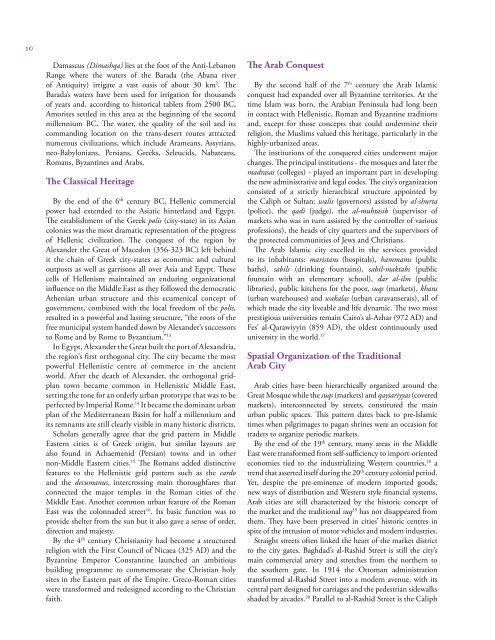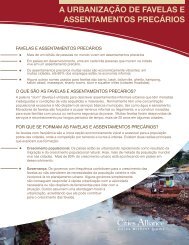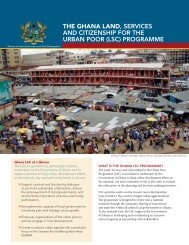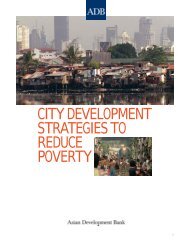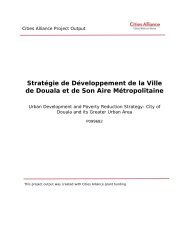Arab Cities2012 - Cities Alliance
Arab Cities2012 - Cities Alliance
Arab Cities2012 - Cities Alliance
You also want an ePaper? Increase the reach of your titles
YUMPU automatically turns print PDFs into web optimized ePapers that Google loves.
10<br />
Damascus (Dimashqa) lies at the foot of the Anti-Lebanon<br />
Range where the waters of the Barada (the Abana river<br />
of Antiquity) irrigate a vast oasis of about 30 km 2 . The<br />
Barada’s waters have been used for irrigation for thousands<br />
of years and, according to historical tablets from 2500 BC,<br />
Amorites settled in this area at the beginning of the second<br />
millennium BC. The water, the quality of the soil and its<br />
commanding location on the trans-desert routes attracted<br />
numerous civilizations, which include Arameans, Assyrians,<br />
neo-Babylonians, Persians, Greeks, Seleucids, Nabateans,<br />
Romans, Byzantines and <strong>Arab</strong>s.<br />
The Classical Heritage<br />
By the end of the 6 th century BC, Hellenic commercial<br />
power had extended to the Asiatic hinterland and Egypt.<br />
The establishment of the Greek polis (city-state) in its Asian<br />
colonies was the most dramatic representation of the progress<br />
of Hellenic civilization. The conquest of the region by<br />
Alexander the Great of Macedon (356-323 BC) left behind<br />
it the chain of Greek city-states as economic and cultural<br />
outposts as well as garrisons all over Asia and Egypt. These<br />
cells of Hellenism maintained an enduring organizational<br />
influence on the Middle East as they followed the democratic<br />
Athenian urban structure and this ecumenical concept of<br />
government, combined with the local freedom of the polis,<br />
resulted in a powerful and lasting structure, “the roots of the<br />
free municipal system handed down by Alexander’s successors<br />
to Rome and by Rome to Byzantium.” 13<br />
In Egypt, Alexander the Great built the port of Alexandria,<br />
the region’s first orthogonal city. The city became the most<br />
powerful Hellenistic centre of commerce in the ancient<br />
world. After the death of Alexander, the orthogonal gridplan<br />
town became common in Hellenistic Middle East,<br />
setting the tone for an orderly urban prototype that was to be<br />
perfected by Imperial Rome. 14 It became the dominant urban<br />
plan of the Mediterranean Basin for half a millennium and<br />
its remnants are still clearly visible in many historic districts.<br />
Scholars generally agree that the grid pattern in Middle<br />
Eastern cities is of Greek origin, but similar layouts are<br />
also found in Achaemenid (Persian) towns and in other<br />
non-Middle Eastern cities. 15 The Romans added distinctive<br />
features to the Hellenistic grid pattern such as the cardo<br />
and the decumanus, intercrossing main thoroughfares that<br />
connected the major temples in the Roman cities of the<br />
Middle East. Another common urban feature of the Roman<br />
East was the colonnaded street 16 . Its basic function was to<br />
provide shelter from the sun but it also gave a sense of order,<br />
direction and majesty.<br />
By the 4 th century Christianity had become a structured<br />
religion with the First Council of Nicaea (325 AD) and the<br />
Byzantine Emperor Constantine launched an ambitious<br />
building programme to commemorate the Christian holy<br />
sites in the Eastern part of the Empire. Greco-Roman cities<br />
were transformed and redesigned according to the Christian<br />
faith.<br />
The <strong>Arab</strong> Conquest<br />
By the second half of the 7 th century the <strong>Arab</strong> Islamic<br />
conquest had expanded over all Byzantine territories. At the<br />
time Islam was born, the <strong>Arab</strong>ian Peninsula had long been<br />
in contact with Hellenistic, Roman and Byzantine traditions<br />
and, except for those concepts that could undermine their<br />
religion, the Muslims valued this heritage, particularly in the<br />
highly-urbanized areas.<br />
The institutions of the conquered cities underwent major<br />
changes. The principal institutions - the mosques and later the<br />
madrasas (colleges) - played an important part in developing<br />
the new administrative and legal codes. The city’s organization<br />
consisted of a strictly hierarchical structure appointed by<br />
the Caliph or Sultan: walis (governors) assisted by al-shurta<br />
(police), the qadi (judge), the al-muhtasib (supervisor of<br />
markets who was in turn assisted by the controller of various<br />
professions), the heads of city quarters and the supervisors of<br />
the protected communities of Jews and Christians.<br />
The <strong>Arab</strong> Islamic city excelled in the services provided<br />
to its inhabitants: maristans (hospitals), hammams (public<br />
baths), sabils (drinking fountains), sabil-maktabs (public<br />
fountain with an elementary school), dar al-ilm (public<br />
libraries), public kitchens for the poor, suqs (markets), khans<br />
(urban warehouses) and wakalas (urban caravanserais), all of<br />
which made the city liveable and life dynamic. The two most<br />
prestigious universities remain Cairo’s al-Azhar (972 AD) and<br />
Fes’ al-Qarawiyyin (859 AD), the oldest continuously used<br />
university in the world. 17<br />
Spatial Organization of the Traditional<br />
<strong>Arab</strong> City<br />
<strong>Arab</strong> cities have been hierarchically organized around the<br />
Great Mosque while the suqs (markets) and qaysariyyas (covered<br />
markets), interconnected by streets, constituted the main<br />
urban public spaces. This pattern dates back to pre-Islamic<br />
times when pilgrimages to pagan shrines were an occasion for<br />
traders to organize periodic markets.<br />
By the end of the 19 th century, many areas in the Middle<br />
East were transformed from self-sufficiency to import-oriented<br />
economies tied to the industrializing Western countries, 18 a<br />
trend that asserted itself during the 20 th century colonial period.<br />
Yet, despite the pre-eminence of modern imported goods,<br />
new ways of distribution and Western style financial systems,<br />
<strong>Arab</strong> cities are still characterized by the historic concept of<br />
the market and the traditional suq 19 has not disappeared from<br />
them. They have been preserved in cities’ historic centres in<br />
spite of the intrusion of motor vehicles and modern industries.<br />
Straight streets often linked the heart of the market district<br />
to the city gates. Baghdad’s al-Rashid Street is still the city’s<br />
main commercial artery and stretches from the northern to<br />
the southern gate. In 1914 the Ottoman administration<br />
transformed al-Rashid Street into a modern avenue, with its<br />
central part designed for carriages and the pedestrian sidewalks<br />
shaded by arcades. 20 Parallel to al-Rashid Street is the Caliph


